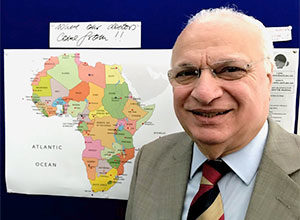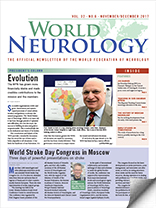The WFN has grown more financially stable and made credible contributions to the mission and the members
By Raad Shakir

Prof. Shakir in front of a map showing where neurology trainees came from, displayed at the Groote Schuur Hospital in Cape Town, South Africa. This is one of the four WFN training centers in Africa.
Successful organizations evolve and grow. Harmonious and uninterrupted processes of sound administration and guidance accelerate this natural progression. The World Federation of Neurology (WFN) is 60 years old. It has been through periods of upheaval and difficulties, but over the years, the success in fulfilling its aims and goals is unquestionable. This is undoubtedly due to the dedication and vision of its leaders.
The constitution and bylaws of the WFN provide a wonderful document that has stood the test of time and is fully adaptable to all situations. It has been the backbone of our federation. It is clear that the trustees govern the WFN. All decisions are made by consensus, and this has been closely followed. This governance structure is a major reason for sound and informed decisions.
If we look at the past decade or so, the WFN has been led by a variety officers and trustees who have come from all regions of the world. It is important that various neurological associations are represented in the leadership. This is assured by the method of nomination and the electoral process we follow.
Over the last decade, the WFN has become more financially sound and able to fulfill its mission in promoting and funding neurological training, education, and research. It is important to say that our financial status has not been affected by the downturn in the world economy 10 years ago. Our financial advice and prudence meant that we continued to increase our assets throughout the past two decades. This has been enormously helped by successful World Congresses.
Neurology Training
It is clear that efforts should be targeted at low- and low-middle-income countries with limited resources and in many non-existing neurology training programs. The facts were made starkly clear by the publication of the Neurology Atlas in 2004. This joint publication of the WFN/WHO remains a major resource for the status of neurology globally. The second edition was published in 2017. It makes interesting reading to look at what has been achieved in over a decade. The differences are glaringly obvious. The status in Sub-Saharan Africa, parts of Latin America and Southeast Asia are dire, to say the least. This was immediately recognized by the WFN leadership during the presidency of Jun Kimura, and the process was started to rectify the situation as much as possible.
Following the success of the Sydney World Congress in 2005 and the establishment of the Task Force for Africa in December 2006, it became clear that a coherent program of training young neurologists in their own regions was the way forward. The decision by the trustees during Johan Aarli’s presidency was to explore the establishment of WFN training centers in Africa as a start. An exploratory visit by Ragnar Stein (Norway) to Rabat and Cairo was positive.
The process of training Africans, by Africans, in Africa, took hold. The last of the quadrennial congresses was held in Bangkok in 2009. Following this, the WFN moved to biennial congresses, further improving the financial status. The foundation of regional organizations for Africa, Asia, and Latin America took hold. This was helped in no small measure by the success of congresses in the regions. The first was the congress in Marrakesh held in 2011 with the banner of “With Africa, For Africa.” The trustees, during the presidency of Valdimir Hachinski, proceeded with the negotiations to establish the first WFN approved training center in Rabat, Morocco. The finances came through a grant from the Moroccan neurology society and the WFN.
Training Centers
The WFN continued with its plans to establish the African Academy of Neurology, and this was finally established during a special meeting in August 2015 in Dakar. This was a momentous event for African neurology. The establishment of three more training centers progressed further. Dakar and Cairo were visited and accredited; the last to be accredited is Cape Town.
Now, the WFN has four centers in Africa, two Francophone and two Anglophone. The fifth one is in Mexico City for Central and South America. The plans for a sixth center in Asia are in hand and should happen in 2018. If we think about Africa, the needs are enormous, as was shown in the second edition of the Neurology Atlas published jointly by the WHO and WFN in September 2017. The WFN is grateful for several funders who have come to partner with the WFN in financially supporting the training centers. As an example, the Societe Francaise de Neurologie (SFN) is supporting the centers in Rabat and Dakar, while the Association of British Neurologists is supporting the training in Cairo. Other societies and regional organizations have pledged financial support, which makes the WFN confident that as an example in Africa we can be assured of producing five trained neurologists a year in due course.
This is most beneficial evidence of the WFN training neurologists in the developing parts of the world. Although arranging teaching courses, traveling fellowships, and bursaries to attend and present scientific work in international meetings are all important activities, I think that the training centers are the most practical and tangible way for young trainees to return to their home countries at the end of training. This will hopefully reduce brain drain to a minimum. Thus far, trained neurologists from our first center in Rabat have returned to their home countries, and the program is functioning exceptionally well. As can be imagined, the most important issue is the dedication of the trainers and the welcoming attitude of all the administrations of training centers. The WFN has seen this in abundance.
Moving Forward
This is my last president’s column during my tenure, having served eight years as Secretary-Treasurer General and four years as President. The final year has seen two other pivotal events for neurology. The first is the classification of stroke as a disease of the nervous system following the WHO’s change of opinion. After 62 years in exile, the WHO has finally agreed to place cerebrovascular disease under the nervous system diseases section of ICD-11. This will ensure that future statistics will clearly show that neurological diseases are the first cause of disability adjusted life years (DALYs) and the second commonest cause of mortality.
The benefits to neurological patients are enormous, as funding should follow, and governments will finally recognize that nervous system diseases are a funding priority. I am most grateful for the WFN trustees and my fellow members of the ICD-11 Topic Advisory Group for their advice and continued support.
The second event is the huge success of the largest World Neurology Congress in Kyoto. The final number of attendees exceeded 8,500, and the Japanese Society of Neurology has been an effective, wonderful host and partner. The scientific and financial reverberation will continue to enrich the WFN is various ways.
I wish the newly elected officers and trustee the best for their continued hard work with the other trustees to move the WFN further forward. With the election this year of Bill Carroll, Ryuji Kaji, and Riadh Gouider, I am confident that the trustees will forge ahead to evolve our activities for a better future for world neurology. I wish them all the best and will always be available for any task whenever required.
